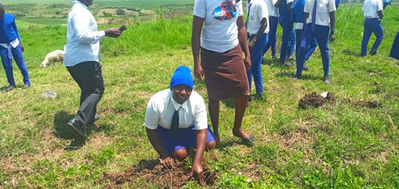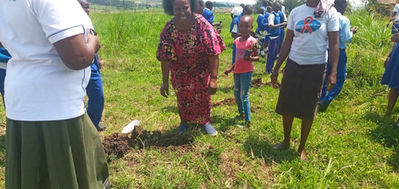Latest Testimonial
Some feedback from one of our customers Dennis Leete on his experience using Homa Lime calcium fertilizer on his vegetables (see photo)

On Mon, 19 Sept 2022 at 11:51, Dennis Leete <dleete2@gmail.com> wrote:
Dear Jimmy,
The gardener brought in a cabbage this morning from the vegetable garden, which weighed 6 kg (15 pounds)!
I cannot explain the science behind this phenomenon, but I recall an agronomist at Kakira Sugar Co in Uganda who had worked at Chemelil many years ago, telling me that you guys could get 9 ratoons of cane, compared to 3 at Chemelil, because you fertilized your crops with your own lime.
I accidentally discovered this when I was growing some strawberries from seed. They exhibited a mineral deficiency which a neighbour suggested was likely to be copper and zinc, from recent soil analysis on his own soils.
The strawberries did respond to an addition of these trace elements, but not as vigorously as I had hoped.
Then I recalled that strawberries in UK liked a basic soil with high calcium levels, and I had some of your calcium fertilizer left and I replanted the strawberries in another area, adding a teaspoon of calcium fertilizer in each hole.
Bingo!
They are doing well.
So I now add your calcium fertilizer to all my vegetable plantings, and my brussels, sweet potatoes, artichokes, rhubarb, carrots, tomatoes, leeks, grow like weeds.
Whether this is a fertilizer effect, or a pH effect I have not discovered. I suppose I should get Cropnuts involved. They are brilliant. But somehow I am enjoying the magical effects, and my neighbours' admiration!
What say you?
Do you have an analysis of your calcium fertilizer, and do you add any other minerals, or ingredients to it?
You might consider marketing it as a vegetable garden fertilizer, where the soils are acid, like Kericho or Nairobi!
I imagine that your apatite deposit also contains phosphates, and other trace elements.
Look forward to your comments,
best,
Dennis
On Mon, 19 Sept 2022 at 16:21, James Brooks <jpb.homalime@gmail.com> wrote:
Dennis,
Thank you for your email and delighted that you are getting such good results with your mbogas.
Our deposit is a carbonatite which contains small amounts of phosphates but not sure if it is in fact an apatite or another compound.
Great news about the cabbage and the strawberries. If not too late, would you be prepared to send me a photo and allow us to reproduce your email on our website and an abridged version on our social media sites, please?
We have had our soils analysed by Cropnuts and they have often reported that our pH is too high and we need to stop applying lime but even when we continue to apply, we still get the results. I have just come in from the shamba looking at a block from which we have just harvested the 15th ratoon. It gave us 48 t/acre after 18 months using the normal rates of fertilizers and herbicides. A nearby block which is 14th ratoon gave us 44 tonnes/acre on conventional management last harvest and has just given us 48 t/acre this time with no bagged fertliser or herbicide. We did interplant with sunflower, cowpeas and crotalaria and it was full of bindweed in spite of handweeding with jembes.
I am very into regenerative agriculture (as far as one can be with a monoculture of cane but in my defense we will not plough and replant the cane in my lifetime, I hope. Rather we just put in a cuttings where we have gaps, to maintain plant population and there is no reason at all why we cannot reach 30 ratoons or more! of cane plus other "weeds"). All our cane is now on handweeding, slashing "weeds", no bagged fertilser or herbicides, but using biogas slurry, compost and worm tea. It looks promising. From what I have read the pH does make a difference of course but analysing soil samples looks at the chemistry. I understand that the soil biology and physics are also important and this may be why the lime in excess may be helping with water holding capacity and other things. I can only say it works for us and glad that it also is helping you.
We do not add anything else to the lime. It is just crushed stone as it came out of the ground.
Jimmy.
On Tue, 20 Sept 2022 at 11:22, Dennis Leete <dleete2@gmail.com> wrote:
Thanks Jimmy,
Most organic decomposition by microflora, produce various organic acids (eg humic acid, wormtea etc ) which react with minute rock particles in soil and breaks them down, so that the symbiotic mycorrhiza on the root tips can help absorb the nutrients and release them into the plants.
At certain levels these acids become toxic and sterilise their environment . Calcium mops them up, and allows the microorganisms to continue to.flourish
At least that's what I think.
A cupful of calcium carbonate (or your calcium fertlizier,) sprinkled on a wheel barrow load of organic waste, speeds up the fermentation breakdown and produces better compost.
That's probably the reason why your high levels of calcium continue to work for your crops at Koru, inspite Cropnuts advice.
Your high rainfall level must also create acid conditions by leaching out the cations, so needs constant replenishment.
Just a thought,
Best,
D




Seedling donation to Our Lady of Mercy School
The above are a few photos from our trip to our Lady of Mercy School in August 2022 to donate some seedlings to them. In the photos you can see Ms Anne Dwele, Lady Justice Onginjo and the students at the school in Muhoroni planting out the seedlings.
Hammerkop House, Nanyuki
Hammerkop House, Nanyuki - Earth and Lime construction. A few years ago my wife and I decided to build our own house. Neither of us had any building experience and we set ourself the challenge of building something as ‘green’ and sustainable as possible. Our top priority was to avoid cement at all costs, so we decided to build a ‘cob’ house that also incorporated lime, particularly in the rendering and floors.
Homa Lime played an important part of our house build. Right at the start of our journey we visited the lime factory in Koru, Kisumu District. We wanted to research where materials were produced and to meet the people involved in it. We also wanted to source high quality lime and get it as fresh as possible. Unexpectedly, we fell in love with the colourful limestones being produced by Home Lime. For anyone who hasn’t seen these, the stone surrounding the lime factory is an incredible mix of red, yellow, green and black limestone. A selection of these ended up forming the stem wall of our home and we used them for the cobble stone floor of our kitchen as well. We actually spent a day at the quarry choosing stones of a particular colour and we found quite a few with fossilised plants in them - a nice touch for the walls!
Our house is predominantly a mud house. The walls are half a meter thick and sculptured by hand. The walls are just mud mixed with wheat straw and some sand. We used lime in perhaps an unusual way. In the right quantities, lime mixes really well with clay. It can help make clay more stable and weather resistant, while it also adds a certain beauty to surfaces. For the internal and external walls of our house we used a combination of lime/clay plasters. In some of the plasters we mixed diatomaceous earth from Nakuru, and marble sand, which gives a real sparkle. For our bathroom we mixed Homa lime, blue pigments and kaolin clay (sourced from the ground near our plot) and then polished it with home made olive oil soap, which reacts with the lime to produce a more water repellent surface. We then polished this with beeswax. We used a similar mix for the floors in our kitchen and bathroom, but added egg whites to the mix, which helps strengthen the lime. The walls and floors of our house are quite unique in Kenya for using no cement at all; just clay and lime.
Beyond substantially reducing our carbon footprint, the result is a surprisingly comfortable house that regulates humidity and stays cool during the day and warm at night. It is really shocking to know how unhealthy ‘modern’ homes are, not only for the environment but also the people living in them. Cement and modern paints contain an awful amount of VOCs and they are breeding grounds for toxic moulds. It would be fantastic if more people would embrace more natural products such as lime and clay in their homes. Hopefully our experiment will inspire a few more people! A big thanks to all those at Homa Lime for supporting us on our house build. And no, termites do not eat cob walls….
Andre & Sophie Standing.











The Homa Lime Sugarcane Story
Written by Jimmy Brooks
The Beginning Cane has been grown on Homa Lime land since 1964. The initial assessments by the experts of the day was that it could not be grown successfully at our altitude (1500 metres) with our temperatures (max 28 OC min 15OC). In most parts of the world, including Kenya the aim is to get 2 or 3 ratoons before ploughing out the old crop and replanting. Homa Lime up until the end of the 1990s averaged 8 ratoons achieving 105 tonnes per ha. over an 18 month growing season. Being on the equator and close to Lake Victoria, we do not have marked wet and dry seasons with varied seasonal temperatures, which is one of the reasons why cane does not mature any quicker. Another is the variety of cane used. We do not irrigate the cane. From the above, it can be seen that the cane except for short occasional periods with break crops between plantings, we are practicing a monoculture. Although other crops do grow, the financial returns from cane exceed any other crop tried, for example, maize, stevia, tobacco, sunflower and coffee. Towards the end of the 1990s, it was realised that soils were deteriorating and we were the first growers in Kenya to change from burning cane before harvesting and then burning trash post harvest. Instead all of the leaves both green and dry were trashlined in every 3rd row....
Magic Bag Article
Your Magic Bag for Soil Conditioning
Written by Joseph Alubakah
Why apply super calcium fertilizer or calcium fertilizer (agricultural lime)?
1. Acidity in the soil is developing with time.
2. The soil’s content of organic matter [humus] is being used up.
3. Certain elements essential to plant and animal growth such as Calcium are being removed by the harvesting of crops and continuous land use.
WHEN TO APPLY
Frequency of application depends on:
• Soil texture
• Nitrogen fertilization rates
• Calcium crop removal
• Amount of Lime applied
• Soil pH range required
Apply one to two months before planting for immediate utilization.
AVAILABLE SOIL CONDITIONERS
Calcium Lime (Super Calcium Fertilizer or Calcium Fertilizer) - High in Calcium and has a high neutralizing value i.e reduces acidity/raises the pH level.
Dolomitic Lime - Contains both calcium and magnesium. Magnesium is a trace element and so is required in very small amounts. Dolomite should not be used frequently.
Gypsum- Contains calcium and sulphur and has a small neutralizing value of about 10% and so is less effective. The sulphur forms sulphuric acid in the soil , so is good for reducing alkalinity in high pH soils.
ADVANTAGES OF LIMING ACID SOILS
• Lowers toxic levels of aluminium and manganese.
• Increases soil microbial activity- decomposition
• Overcomes the potential for Calcium deficiency
• Increases symbiotic nitrogen fixation in legumes.
• Increases availability of phosphorus and molybdenum
• Improves water retention in the soil. The following organisations are already using our products for soil treatment and increased yields:
1. James Finlays (K) Ltd – Kericho
2. Unilever Tea (K) Ltd – Kericho
3. Tropical Farm Management – Nairobi
4. Crop Africa – Nairobi
5. Western Seed – Kitale
6. Mumias Sugar Co. Ltd – Mumias
7. Nzoia Sugar Co. Ltd – Nzoia
8. Kaweri Coffee Plantation – Uganda
9. KARI & AGRA – Supports the liming program
10. S.P. Kruger - Eldoret + many others.
Before Application

After Application

_edited_edited.jpg)
_JPG.jpg)
Partnership with CROPNUTS
CROP NUTRITION LABORATORY SERVICES Ltd.
In order to optimize production from your land it is essential to have the correct soil fertility conditions. Having a healthy, well balanced soil with the correct pH and calcium/magnesium ratio soil will mean farmers can reduce fertilizer and pesticide inputs, as the crop is able to access more nutrients from the soil and remains healthy to fight of diseases and pest attacks.
Crop Nutrition Laboratory Services Ltd (CROPNUTS) was established in 1998 and is East Africa's leading independent, ISO17025 accredited soil, plant & water testing laboratory (www.cropnuts.com). CROPNUTS provides soil testing services to farmers through its DAKTARI wa UDONGO (Soil Doctor) Agent program. CROPNUTS will carry out full soil analysis on farmers soils and advise on the correct amount and type of lime and fertilizers to correct and balance your soil conditions for the particular crop you wish to grow.
Homa Lime Co. Ltd. has now been appointed an agent for Crop Nutrition Laboratory Services Ltd.
For anyone wishing to have soil testing carried out, please contact Homa Lime direct or through Nyando Valley Development Trust staff. They will advise on sampling methods and will collect the samples from the farmer and forward to Nairobi for testing. The testing will be charged for at prescribed rates by the Laboratory.
Read the following case study to see how a farmer in Trans Nzoia increase profit by 81% by carrying out soil testing through DAKTARI wa UDONGO (click on the link below)
The Importance of Calcium
Written by Joseph Alubakah
1. Most soils are acidic due to leaching, atmospheric pollution and application of nitrogenous fertilisers which tend to break down in the soil to form nitric and sulphuric acids – addition of Calcium (Ca) controls this situation.
2. At different pH levels other nutrients become more or less readily available to plants. This can result in toxicity or deficiency of particular nutrients.
3. The correct soil pH is essential for efficient utilisation of artificial fertilizers. The ideal soil pH is about 6-6.5 for most crops. Addition of calcium will correct acidic soils.
4. Microbial activity is also affected by pH and this is important in the break down of organic matter.
5. Calcium imparts stability to the soil resulting in better water absorption, better water retention and improved microclimate of the soil with more air spaces, this helps improve microbial activity.
6. When quick soil reaction is required it may be advisable to use Hydrated Lime because:- a. It has high neutralizing power due to high Ca composition. b. It has finer particles.
7. Calcium is an essential nutrient.
8. When should one apply Calcium. a. After testing the soil. b. pH or Ca levels in the soil are low. c. Response of plants to artificial fertilizers is poor.
9. Lime should ideally be applied and incorporated into the soil at least one or two months before your crop is planted. This will allow time for correction of your soils, so one is planting into an improved environment.
10. Remember: a. The effect of liming correctly will last for about 4 - 5 years. b. The lime should be applied so as to improve the whole shamba. c. It is no good applying to the planting hole for maize. Next year, you will miss using the same hole. d. All crops require correct pH for maximum nutrient utilization.
For more information contact Crop Nutrition Laboratory Services. NB: pH is the measure of acidity or alkalinity of the soil. Neutralizing value (NV) is a measure of the ability of a liming material to neutralize acidity compared with pure calcium carbonate. Pure limestone has an NV of 100. Use HOMA LIME SUPER CALCIUM FERTILISER or CALCIUM FERTILISER to correct Calcium deficiency and excessive soil acidity and improve yields.





















